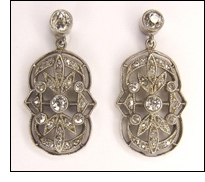Antique Jewellery
Posted by Gill Jones on 13/01/2014
 Christmas may be over, but for some of you, you’re already thinking ahead. It would seem that many of us were born around spring time, which means that once February has left us, March onwards sees a plethora of birthday celebrations until May is out. Anniversaries seem to be abundant in spring too so there’s another occasion to celebrate.
Christmas may be over, but for some of you, you’re already thinking ahead. It would seem that many of us were born around spring time, which means that once February has left us, March onwards sees a plethora of birthday celebrations until May is out. Anniversaries seem to be abundant in spring too so there’s another occasion to celebrate.
To mark an occasion
If you’ re thinking about what to buy your loved one, jewellery is never a bad idea, you may be thinking brand new, or even contemplating an older piece. They can spark off an enthusiastic collection, or perhaps over time you may not be bothered about whether they increase in value. They may only serve to mark a special time in your life and their value is sentimental rather than financial.
A long history
Jewellery has a long history going back to prehistoric times. It was worn for appearances but also to represent status, wealth, friendship and grief amongst other things. Rings were worn on the toes as well as on the fingers. Almost every material imaginable has been used to create a beautiful piece of jewellery from precious metals to gemstones, from hard stones, to human hair. Most antique jewellery that survives is from the late 18th and 19th century, changing in style and material over the years.
Cameos
Cameos were once very popular and even more so in the 19th century. They were usually made of hardstone, sardonyx or cornelian. They were meant to show off a design carving so would often come with a dark background.
Mythological subjects were very popular during the 19th century. The Victorian cameo on www.antiques.co.uk is a prime example of this with Ajax as its central figure. He played a central figure in Homer’s Iliad. Ajax’s head and shoulders are carved from slightly pink hardstone with a dark background. It’s surrounded by a diamond and natural pearl border. It can be worn either as a brooch or a pendant.
Earrings
Again, earrings that have survived today are usually from the 19th century, trends at this time went from pendant loop earrings, sometimes almost reaching the shoulders in a chandelier or girandole style, to shorter ones. For a short time during the mid-Victorian period when the hair was worn low over the ears, earrings went out of fashion. Towards the end of the 19th century clip-ons had been invented which meant that women without pierced ears could now wear earrings.
These leaf pattern earrings on www.antiques.co.uk are from the early Victorian period, although not as long as some of the earrings of this time, they are exquisite all the same. The textured leaves are made from almandine garnets and come with shepherd’s crook ear wires.
Rings
Rings have been around since Egyptian times. They haven’t always been worn on the fingers either; they were sometimes worn on the toes. Rings could often have symbolic meaning from bereavement, to love. Snakes were popular and also serpents, which would often come with several bands with a single or double head. Mourning rings were popular and there are a few on www.antiques.co.uk worth taking a look at. Gypsy rings were also firm favourites. The 5-diamond gypsy ring on www.antiques.co.uk is typical of this type of design. Gypsy rings had a gold band and would normally have more than 2 stones deeply set within the metal. This makes them ideal if you’re worried about scratching the stones.
Whatever you’re looking for, always look out for scratches, chipping, and dents and where possible ask to look at them. Whatever you have in mind there’s an excellent choice on www.antiques.co.uk so take a look, you never you know, you may find exactly what you’re looking for.





